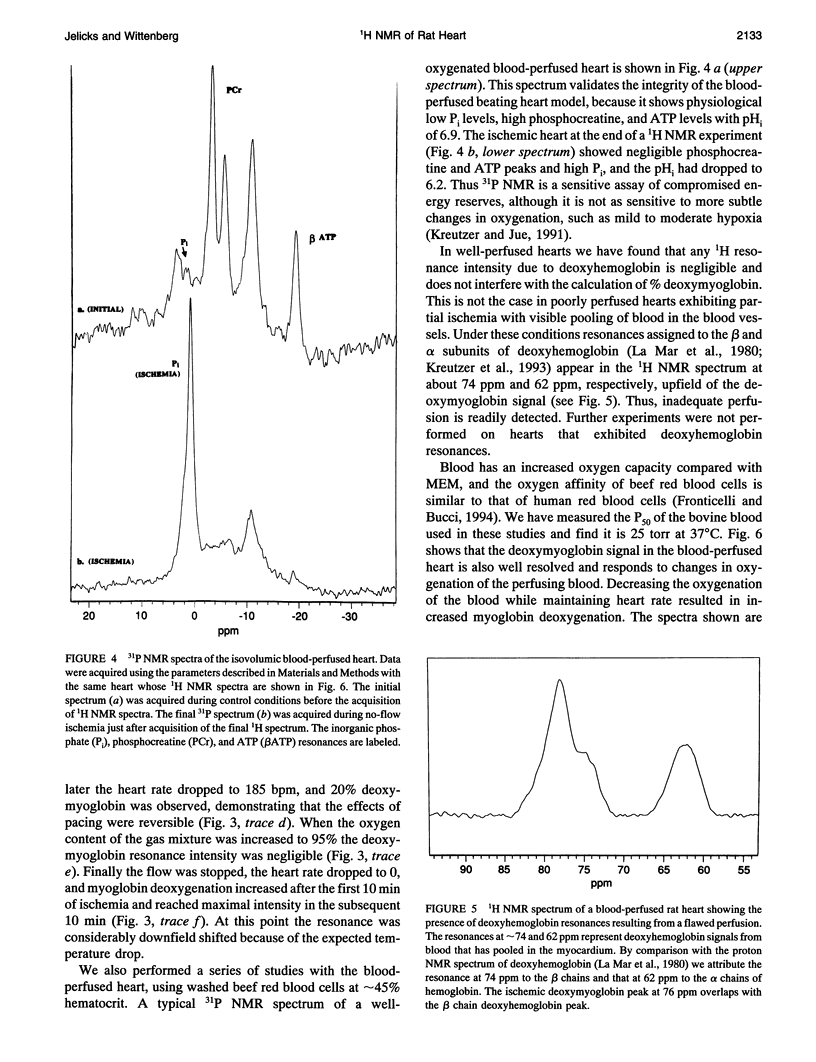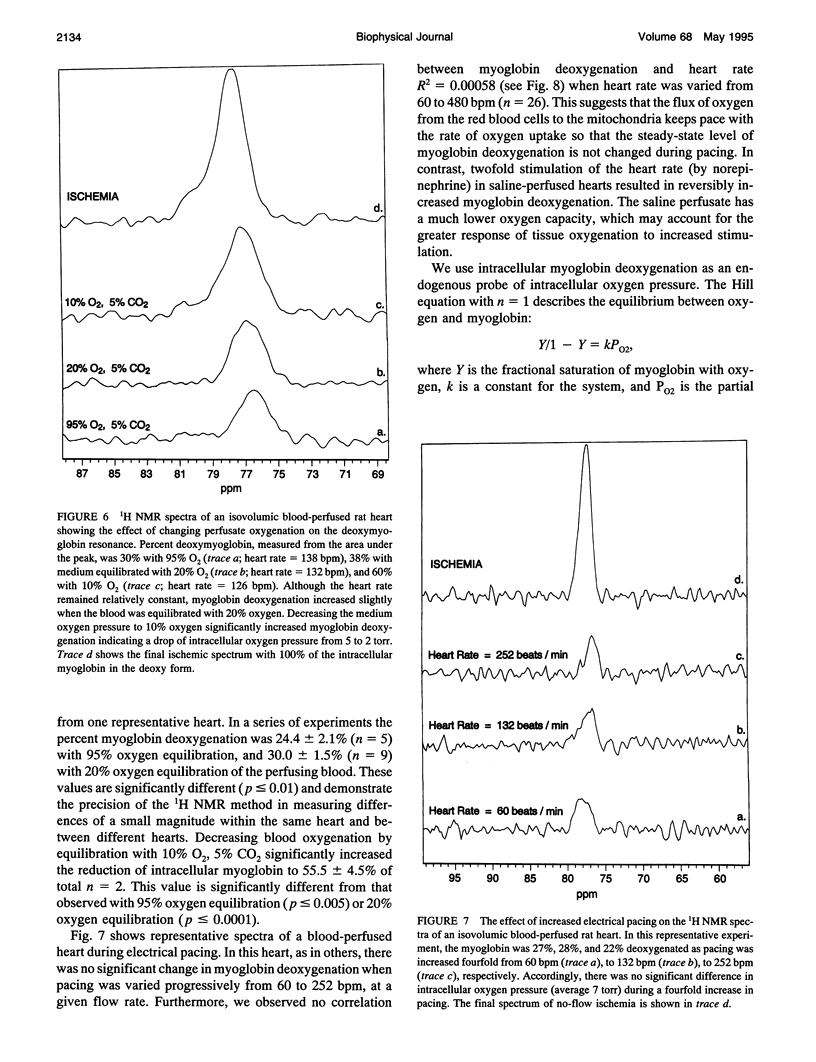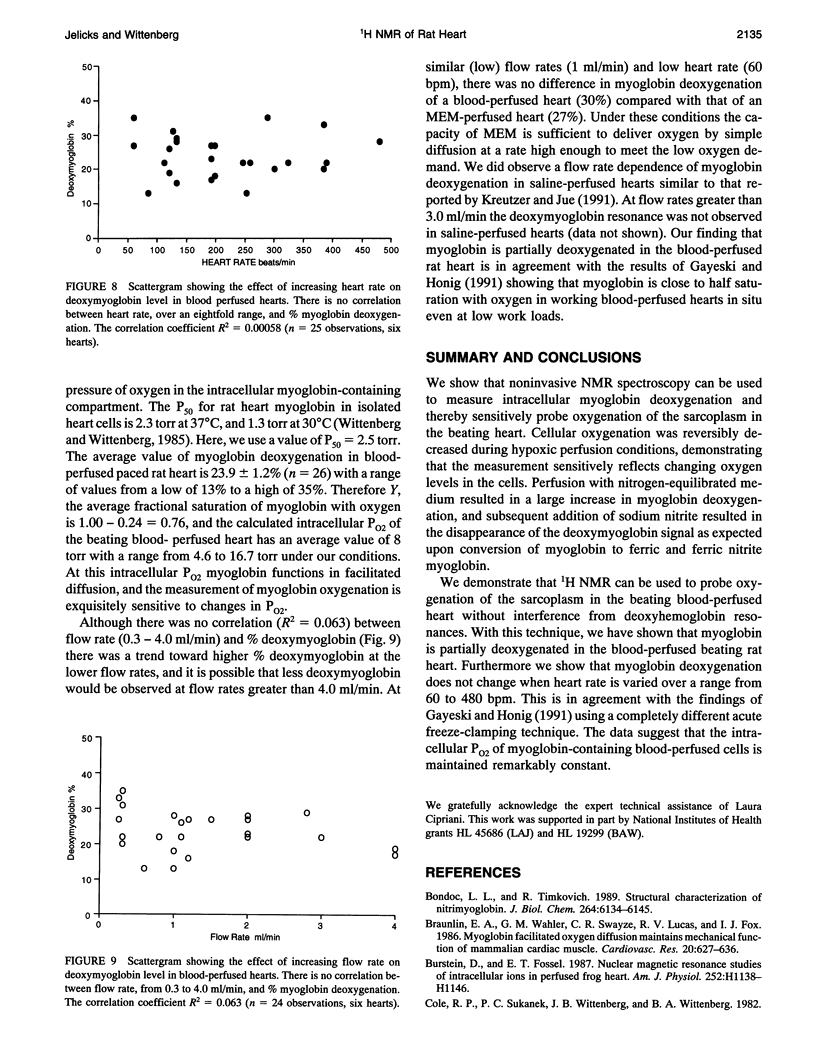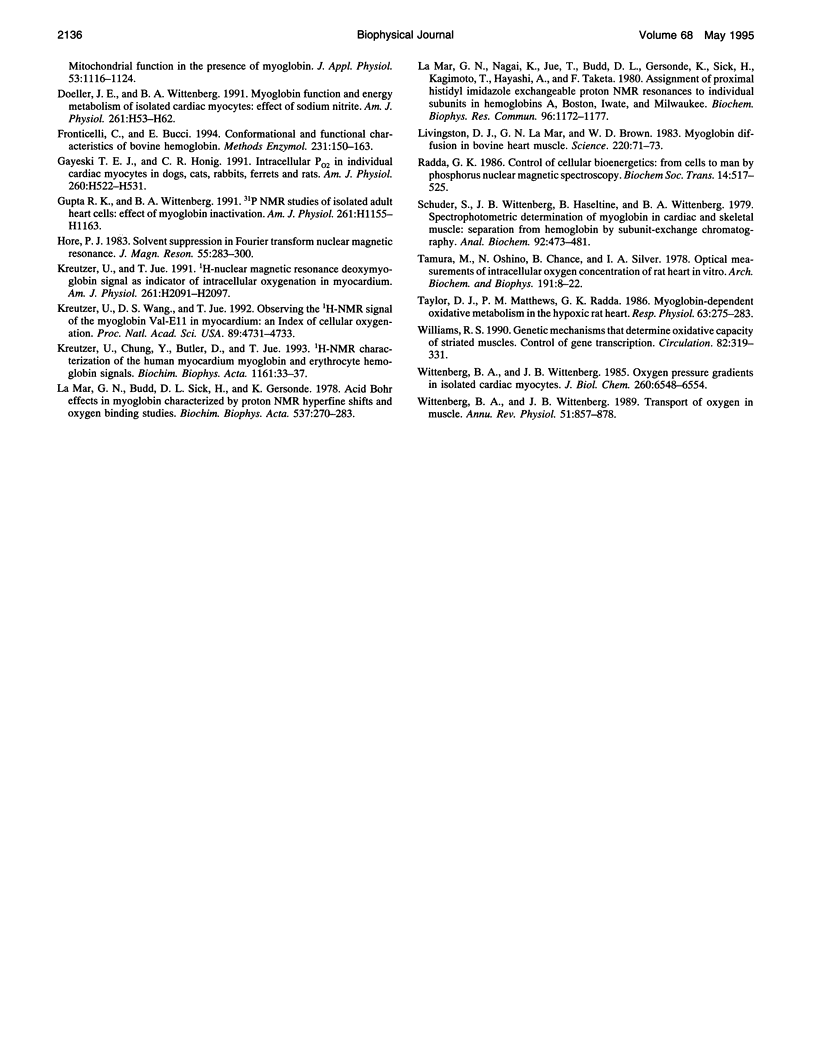Abstract
The proximal histidine N delta H proton of deoxymyoglobin experiences a large hyperfine shift resulting in its 1H nuclear magnetic resonance (NMR) signal appearing at approximately 76 ppm (at 35 degrees C), downfield of the diamagnetic spectral region. 1H NMR of this proton is used to monitor sarcoplasmic oxygen pressure in isolated perfused rat heart. This method monitors intracellular oxygenation in the whole heart and does not reflect oxygenation in a limited region. The deoxymyoglobin resonance intensity is reduced upon conversion of myoglobin to the ferric form by sodium nitrite. 1H resonances of the N delta H protons of the alpha and beta subunits of bovine deoxyhemoglobin do not interfere with the measurement of myoglobin deoxygenation in blood-perfused rat heart. We find that steady-state myoglobin deoxygenation is increased progressively (and reversibly) as oxygenation of the perfusing medium is decreased in both saline and red blood cell-perfused hearts at constant work output. An eightfold increase in the heart rate of the blood-perfused heart resulted in no change in the deoxymyoglobin signal intensity. Intracellular PO2 of myoglobin-containing cells is maintained remarkably constant in changing work states.
Full text
PDF







Selected References
These references are in PubMed. This may not be the complete list of references from this article.
- Bondoc L. L., Timkovich R. Structural characterization of nitrimyoglobin. J Biol Chem. 1989 Apr 15;264(11):6134–6145. [PubMed] [Google Scholar]
- Braunlin E. A., Wahler G. M., Swayze C. R., Lucas R. V., Fox I. J. Myoglobin facilitated oxygen diffusion maintains mechanical function of mammalian cardiac muscle. Cardiovasc Res. 1986 Sep;20(9):627–636. doi: 10.1093/cvr/20.9.627. [DOI] [PubMed] [Google Scholar]
- Burstein D., Fossel E. T. Nuclear magnetic resonance studies of intracellular ions in perfused frog heart. Am J Physiol. 1987 Jun;252(6 Pt 2):H1138–H1146. doi: 10.1152/ajpheart.1987.252.6.H1138. [DOI] [PubMed] [Google Scholar]
- Cole R. P., Sukanek P. C., Wittenberg J. B., Wittenberg B. A. Mitochondrial function in the presence of myoglobin. J Appl Physiol Respir Environ Exerc Physiol. 1982 Nov;53(5):1116–1124. doi: 10.1152/jappl.1982.53.5.1116. [DOI] [PubMed] [Google Scholar]
- Doeller J. E., Wittenberg B. A. Myoglobin function and energy metabolism of isolated cardiac myocytes: effect of sodium nitrite. Am J Physiol. 1991 Jul;261(1 Pt 2):H53–H62. doi: 10.1152/ajpheart.1991.261.1.H53. [DOI] [PubMed] [Google Scholar]
- Fronticelli C., Bucci E. Conformational and functional characteristics of bovine hemoglobin. Methods Enzymol. 1994;231:150–163. doi: 10.1016/0076-6879(94)31012-2. [DOI] [PubMed] [Google Scholar]
- Gayeski T. E., Honig C. R. Intracellular PO2 in individual cardiac myocytes in dogs, cats, rabbits, ferrets, and rats. Am J Physiol. 1991 Feb;260(2 Pt 2):H522–H531. doi: 10.1152/ajpheart.1991.260.2.H522. [DOI] [PubMed] [Google Scholar]
- Gupta R. K., Wittenberg B. A. 31P-NMR studies of isolated adult heart cells: effect of myoglobin inactivation. Am J Physiol. 1991 Oct;261(4 Pt 2):H1155–H1163. doi: 10.1152/ajpheart.1991.261.4.H1155. [DOI] [PubMed] [Google Scholar]
- Kreutzer U., Chung Y., Butler D., Jue T. H-NMR characterization of the human myocardium myoglobin and erythrocyte hemoglobin signals. Biochim Biophys Acta. 1993 Jan 15;1161(1):33–37. doi: 10.1016/0167-4838(93)90192-t. [DOI] [PubMed] [Google Scholar]
- Kreutzer U., Jue T. 1H-nuclear magnetic resonance deoxymyoglobin signal as indicator of intracellular oxygenation in myocardium. Am J Physiol. 1991 Dec;261(6 Pt 2):H2091–H2097. doi: 10.1152/ajpheart.1991.261.6.H2091. [DOI] [PubMed] [Google Scholar]
- Kreutzer U., Wang D. S., Jue T. Observing the 1H NMR signal of the myoglobin Val-E11 in myocardium: an index of cellular oxygenation. Proc Natl Acad Sci U S A. 1992 May 15;89(10):4731–4733. doi: 10.1073/pnas.89.10.4731. [DOI] [PMC free article] [PubMed] [Google Scholar]
- La Mar G. N., Budd D. L., Sick H., Gersonde K. Acid Bohr effects in myoglobin characterized by proton NMR hyperfine shifts and oxygen binding studies. Biochim Biophys Acta. 1978 Dec 20;537(2):270–283. doi: 10.1016/0005-2795(78)90510-x. [DOI] [PubMed] [Google Scholar]
- La Mar G. N., Nagai K., Jue T., Budd D. L., Gersonde K., Sick H., Kagimoto T., Hayashi A., Taketa F. Assignment of proximal histidyl imidazole exchangeable proton NMR resonances to individual subunits in hemoglobins A, Boston, Iwate and Milwaukee. Biochem Biophys Res Commun. 1980 Oct 16;96(3):1172–1177. doi: 10.1016/0006-291x(80)90075-3. [DOI] [PubMed] [Google Scholar]
- Livingston D. J., La Mar G. N., Brown W. D. Myoglobin diffusion in bovine heart muscle. Science. 1983 Apr 1;220(4592):71–73. doi: 10.1126/science.6828881. [DOI] [PubMed] [Google Scholar]
- Radda G. K. Control of bioenergetics: from cells to man by phosphorus nuclear-magnetic-resonance spectroscopy. Eighteenth CIBA medal lecture. Biochem Soc Trans. 1986 Jun;14(3):517–525. doi: 10.1042/bst0140517. [DOI] [PubMed] [Google Scholar]
- Schuder S., Wittenberg J. B., Haseltine B., Wittenberg B. A. Spectrophotometric determination of myoglobin in cardiac and skeletal muscle: separation from hemoglobin by subunit-exchange chromatography. Anal Biochem. 1979 Jan 15;92(2):473–481. doi: 10.1016/0003-2697(79)90687-0. [DOI] [PubMed] [Google Scholar]
- Tamura M., Oshino N., Chance B., Silver I. A. Optical measurements of intracellular oxygen concentration of rat heart in vitro. Arch Biochem Biophys. 1978 Nov;191(1):8–22. doi: 10.1016/0003-9861(78)90062-0. [DOI] [PubMed] [Google Scholar]
- Taylor D. J., Matthews P. M., Radda G. K. Myoglobin-dependent oxidative metabolism in the hypoxic rat heart. Respir Physiol. 1986 Mar;63(3):275–283. doi: 10.1016/0034-5687(86)90095-2. [DOI] [PubMed] [Google Scholar]
- Williams R. S. Genetic mechanisms that determine oxidative capacity of striated muscles. Control of gene transcription. Circulation. 1990 Aug;82(2):319–331. doi: 10.1161/01.cir.82.2.319. [DOI] [PubMed] [Google Scholar]
- Wittenberg B. A., Wittenberg J. B. Oxygen pressure gradients in isolated cardiac myocytes. J Biol Chem. 1985 Jun 10;260(11):6548–6554. [PubMed] [Google Scholar]
- Wittenberg B. A., Wittenberg J. B. Transport of oxygen in muscle. Annu Rev Physiol. 1989;51:857–878. doi: 10.1146/annurev.ph.51.030189.004233. [DOI] [PubMed] [Google Scholar]


